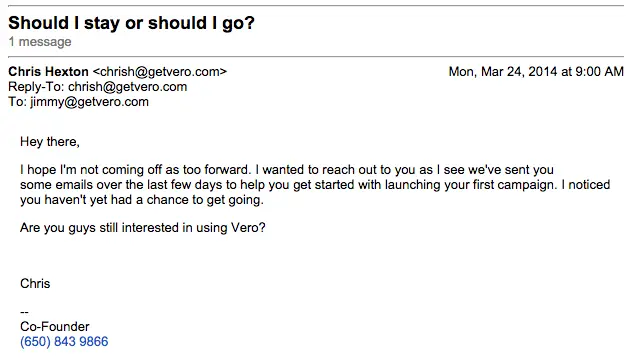- All Posts
- /
- Behavioral Emails
Behavioral Emails
Messaging and Automation-
 Jimmy Daly
Jimmy Daly
-
Updated:Posted:
On this page
Behavioral emails are automated emails triggered by a customer’s interaction with your website, product or app. In this guide, you’ll learn about different types of behavioral emails, examples and best practices.
‘Here’s That Thing You Asked For’ Emails
When people request something from you – an ebook, download, more info, etc. – they are nearly guaranteed to open the email that delivers that thing. Make sure the email: 1) delivers that thing and 2) has something else to offer.
Take a look at a few examples to see what we mean.
KISSmetrics
This email from KISSmetrics has three unique calls to action in order of priority.
First, they give you the link to download the report you requested.
Next, they ask you to share the link with a friend if you find it interesting.
And lastly, they ask you to sign up for a free trial.
And why not? You’ve already shown serious interest in KISSmetrics by navigating to their site and requesting more information. It’s a nicely done email with all the right prompts.
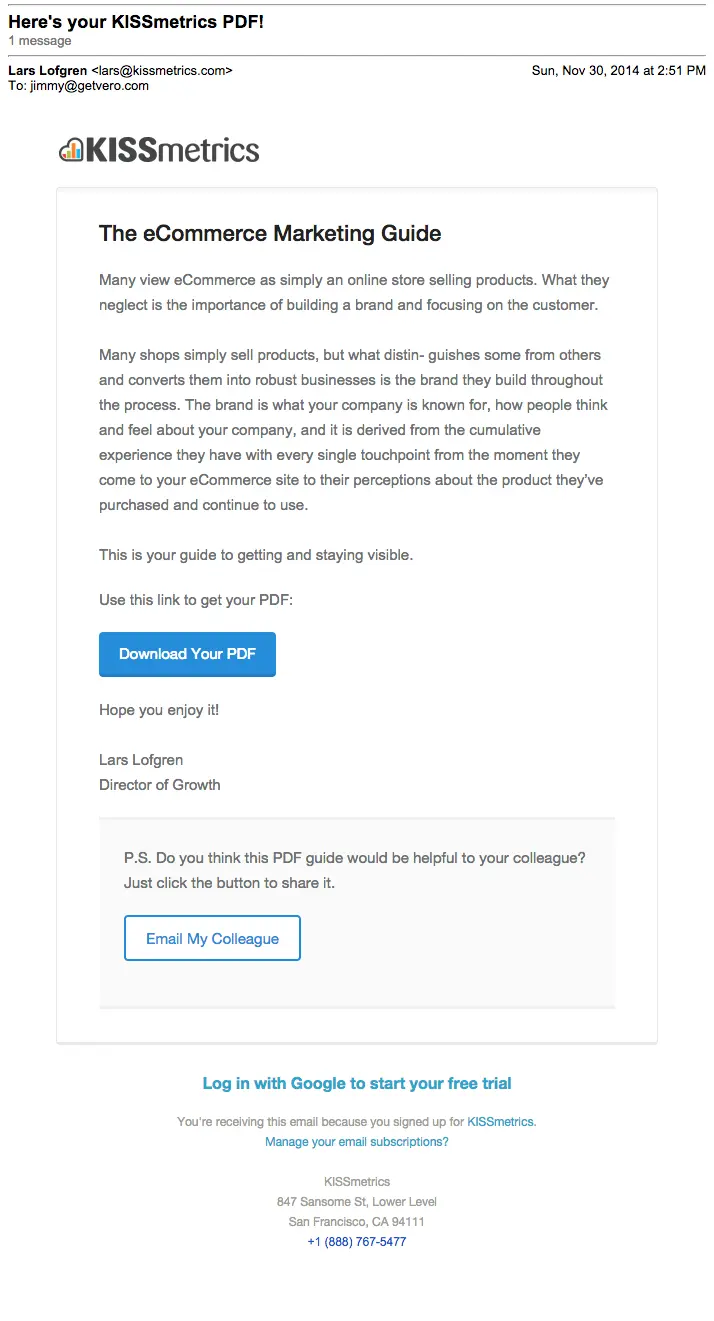
Nir Eyal
Nir Eyal is an expert on forming habits and, in this email, he’s planting the seeds of a new habit. Once he delivers the requested information, he adds the key line:
“Oh, and keep an eye on your inbox – more freebies will be coming your way shortly!”
He is setting an expectation for more emails and more value. With that knowledge, will you open the next email he sends? Of course, because you know it’s going to contain something great.
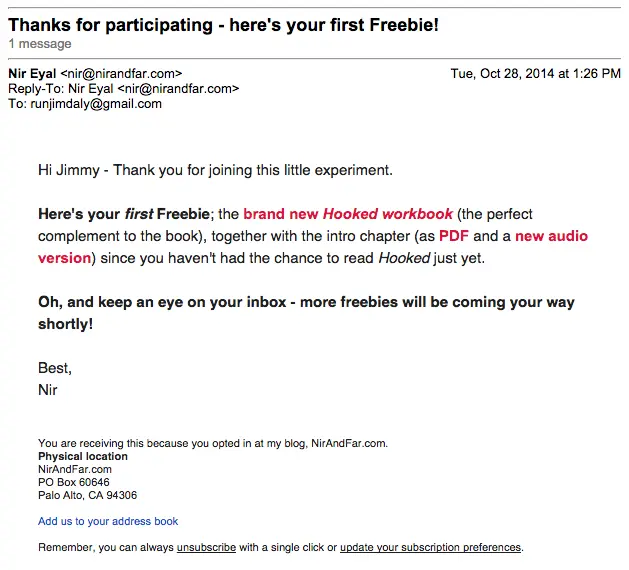
Vero
When readers check out our guide Email Marketing Best Practices: 20 Tips for Dramatically Better Emails, we offer them a swipe file of email inspiration. This is the email they get when they request it.
Here, we’ve employed the Samuel L. Jackson marketing hack. When readers click to share via email or tweet, the message is pre-populated with content and a call to action. It turns our readers into marketers.
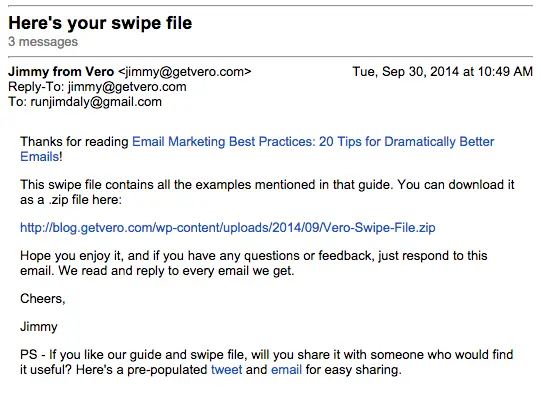
[toc_chapter_title color=”red” number=”2″ title=”Abandoned Shopping Cart Emails”]
According to the Baymard Institute, 68.07 percent of shopping carts are abandoned.
And according to Marketing Land, “more than half of cart retrieval emails are opened, and over a third of cart retrieval emails result in purchases.”
There is no reason not to send abandoned cart emails. Here are a few examples to get you started.
Fifty Three
This email, which was first featured on the Shopify blog, is short, sweet yet still personalized. It shows the exact product the customer added to the cart and asks them to continue the checkout process.
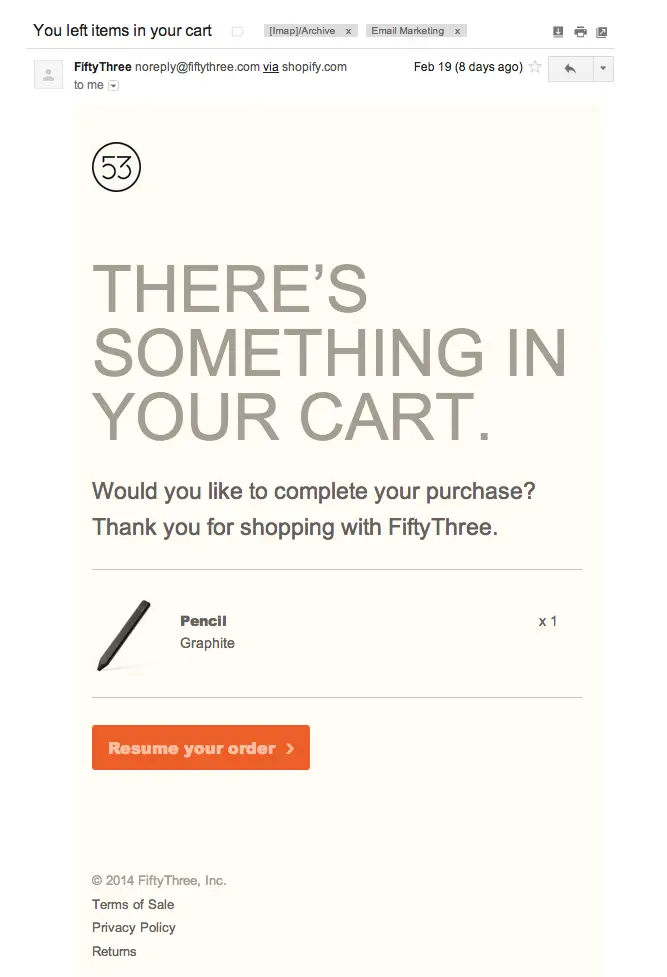
Target
Here’s a more sophisticated example. Target shows the customer the product, then offers a $5 discount that’s only available for four days.
Then, they employ “plan B”.
Here’s what Target knows for sure. The customer is very interested in this item (they put it in their shopping cart) but they aren’t totally convinced (they haven’t completed the purchase yet).
So Target shows related items in the same price range. This could result in a sale but it will definitely result in more data for Target’s marketing team. The customer could click another product (a sign that they are outfitting an entire apartment or house) or click nothing (a sign that all they really need is a table).

Nomad
Incentive + urgency = sales.
In this example also from the Shopify blog, Nomad applies a bit by pressure by offering a discount for 48 hours. That pushes interested customers over the line and seals the deal.
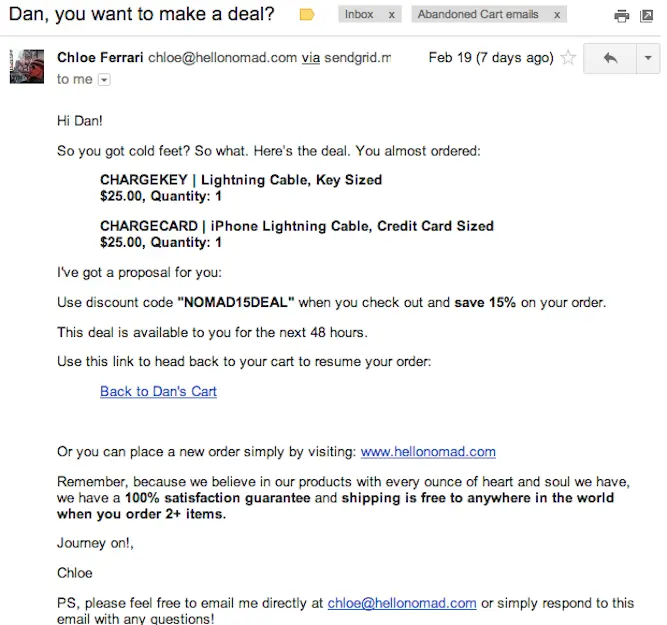
Browsing History Emails
Your browsing history shows intent.
Only a handful of business have mastered the art of turning browsing history into a sales tool.
These emails use the same tactics as abandoned shopping cart emails but are used for customers a few steps back in the conversion funnel.
Here are some examples from the best in the business.
And check out How to Send Behavioral Emails That Will Boost Your Conversions for more.
Airbnb
Here are five reasons we love this email:
- It is personalized and triggered as a direct result of my behavior on their site.
- It features a bold button with friction-free conversion language.
- They had a backup plan.
- It addresses my anxieties.
- It includes micro CTAs.
We’ve broken this email down in detail here.
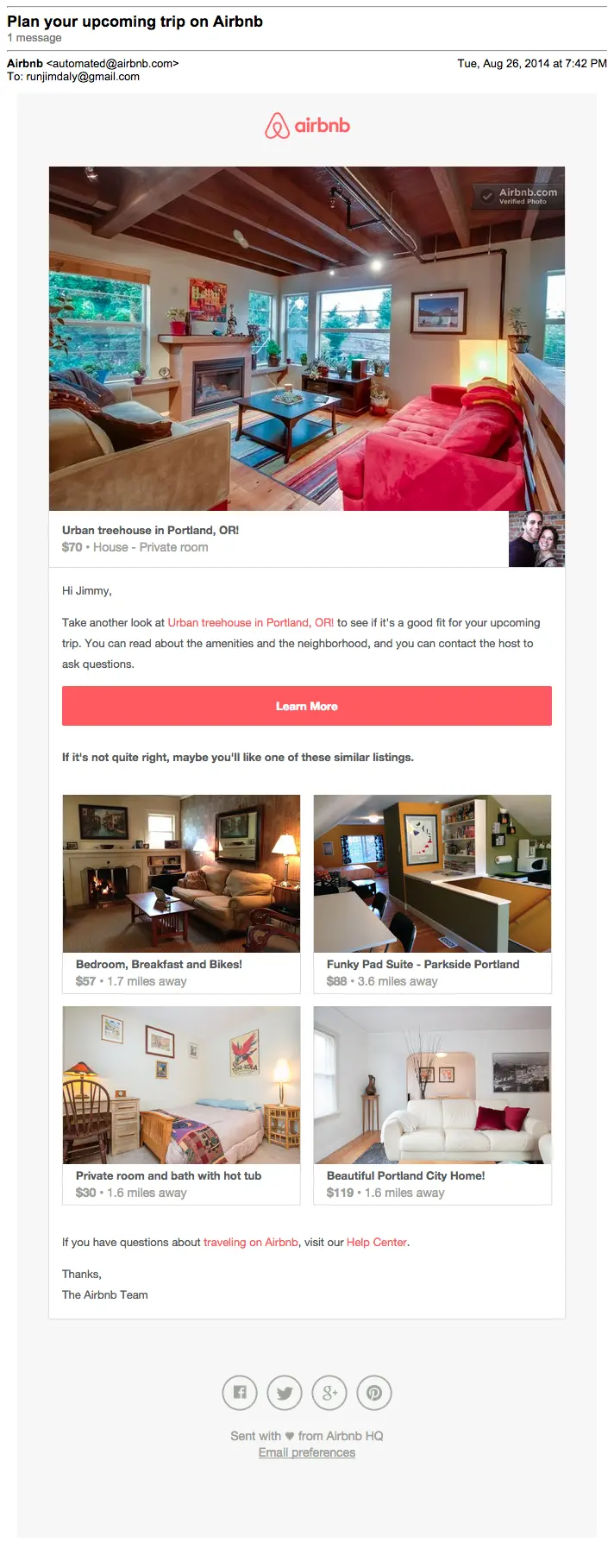
Amazon
I never thought someone would ask me, “Are you looking for something in our Pet Apparel department?”
(We’ve committed to being transparent on the Vero blog, even if it’s cringeworthy.)
Did you know that you could dress your dog up as a pumpkin, peacock or orca? This email is fabulous for the entertainment value alone but it’s also data-driven. I did indeed search for a Halloween costume for my dog, so they have quantitative evidence that I should be interested in the products displayed here. It comes at the just the right time in the buying cycle since I’ve expressed clear interest but haven’t made a purchase.
Read more How Amazon Dominates E-Commerce With Email Marketing.

TripAdvisor
TripAdvisor emails are totally conversion-focused. Every email they send (and they send a lot) have a goal.
The site runs on reviews, so many of their emails are designed to get users to write reviews. This is one of those emails.
They know that I checked out this place on their site recently and are curious if I ended up going. Not only does this help them get data on this listing, but it helps them figure out when in the customer lifecycle people do their research.
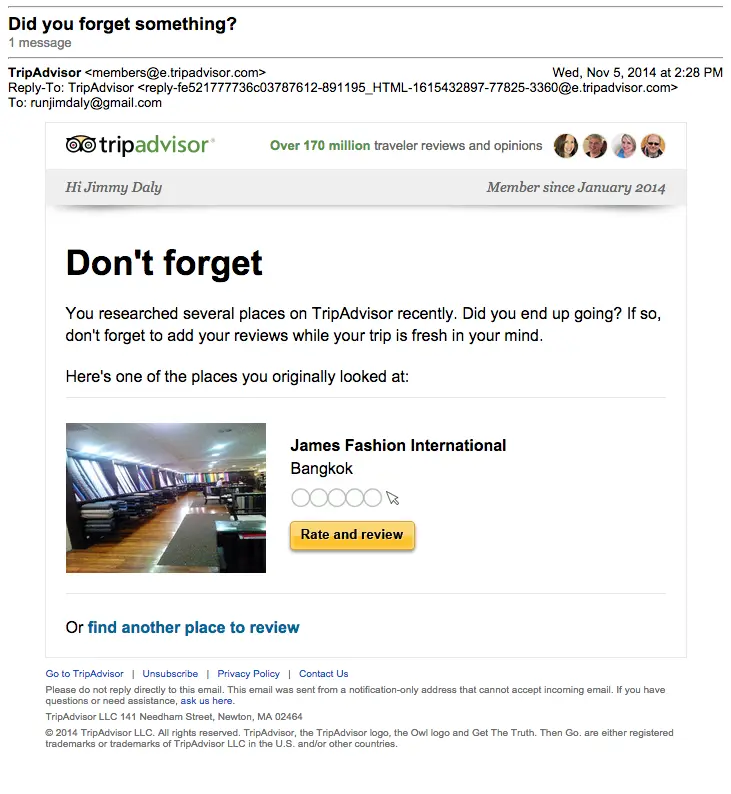
Account information Emails
If your product or service requires any setup – downloading an app, installing a browser extension, connecting an account, etc. – you face some unique onboarding challenges.
If users don’t setup their account properly, you can’t provide any value.
These emails are transactional and behavioral. They are letting users know something important about their account but they are also data-driven (i.e. sent only to people whose behavior or account warrants the message).
They are also promotional in that a conversion will deliver value for the user and keep customers happy.
Mint
Mint only works if users plugin their bank accounts, credit cards and other financial information. This email is letting the user know that Mint is unable to collect data because of an issue with a financial institution’s website integration.
It does a good job of creating a sense of anxiety that the recipient feels must be resolved.
“We’re having trouble connecting to your financial accounts. This might be due to bank security precautions or policy changes.”
That sounds serious. And it’s followed by a strong call to action to get the issue resolved.
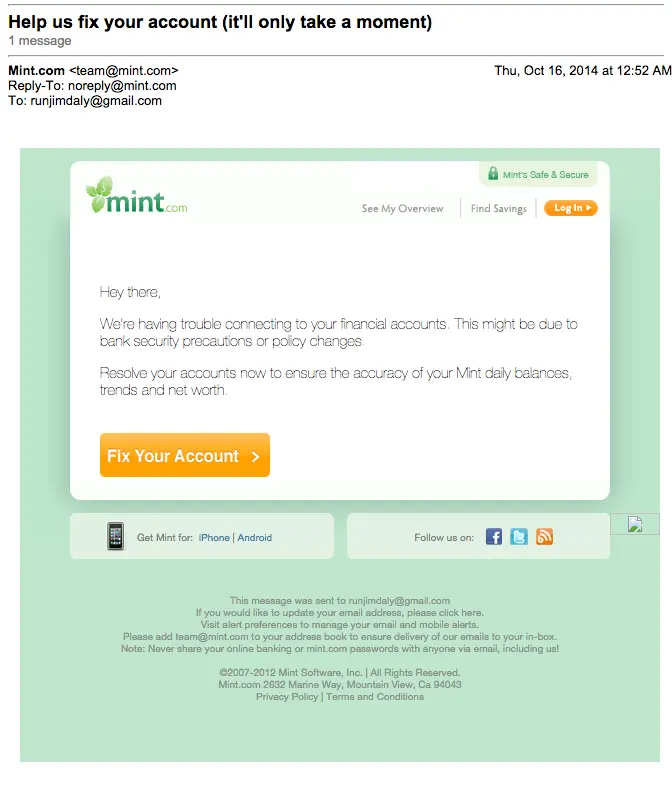
SaneBox
The subject line of this email – “Your account has been disabled” – is indicative of a transactional message but the truth is this is marketing email.
The goal of this email is to get users’ accounts setup properly so they can actually use the product. If this doesn’t happen within the 14-day free trial window, it’s highly unlikely the user will upgrade.
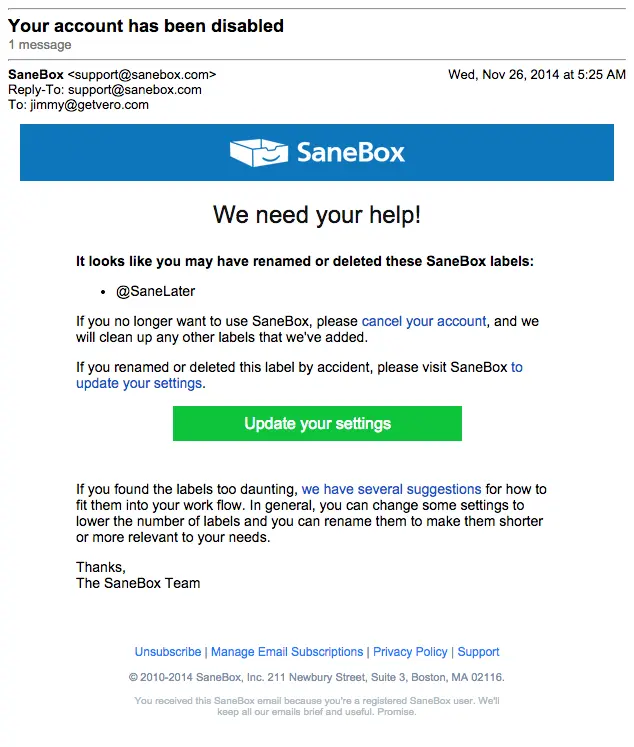
Buffer
This email is a little different since it looks like something went wrong on Buffer’s end but the idea is the same. It gets users engaged to help fix an issue, therefore delivering value and keeping the train rolling.
Notice how Buffer also uses the opportunity to interact with the customer support team – a huge perk of being a Buffer user.

Review Emails
Are you getting tired of seeing examples from Airbnb, Amazon, and TripAdvisor?
These guys are killing it with transactional, behavioral and promotional email.
Yes, they have massive budgets but they are executing on some very basic ideas. Gathering product reviews is one example. The data is hugely valuable to the business and the customers yet so few companies send these emails.
If you take nothing else away from this guide, remember this: Execution will take you a lot farther than a big budget.
Airbnb
Companies like eBay have already done the hard work of convincing consumers that leaving reviews is a helpful thing to do. Leaving a review helps your peers and since we’ve all read reviews, we all understand how helpful they can be.
Airbnb employs a new tactic. Customers must leave a review to see what others say about them. They also put a time limit on the process to nudge users into taking action.
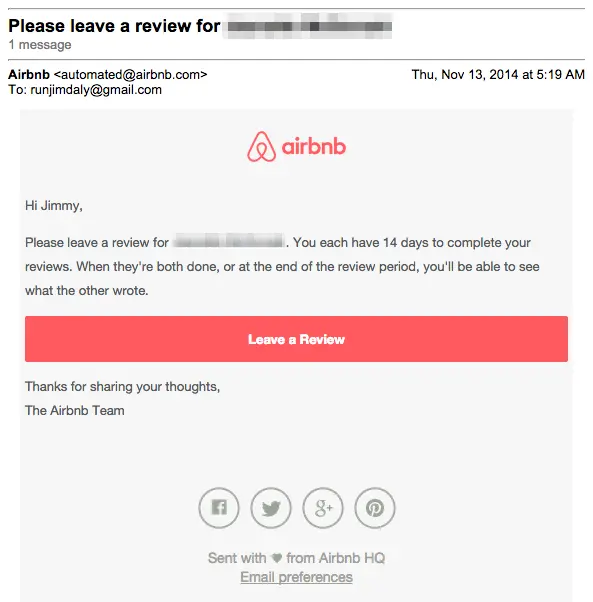
Amazon
What’s the first thing you check when you are looking at a product on Amazon? The reviews, of course.
Social proof isn’t a new concept but Amazon is the first to prioritize and scale it. Every time a purchase is made, Amazon asks the customers for feedback. The feedback, in turn, helps other customers make smart purchases, creating a better customer experience for everyone.
Not in the email above that Amazon is very specific about the feedback they want.
“How did the size large fit?”
Simply clicking the appropriate review automatically adds data to the product page. The user is brought to a page where they can leave a review and give the product a star rating. Amazon has been able to scale this process because people are helping each other, and Amazon benefits as a by-product.
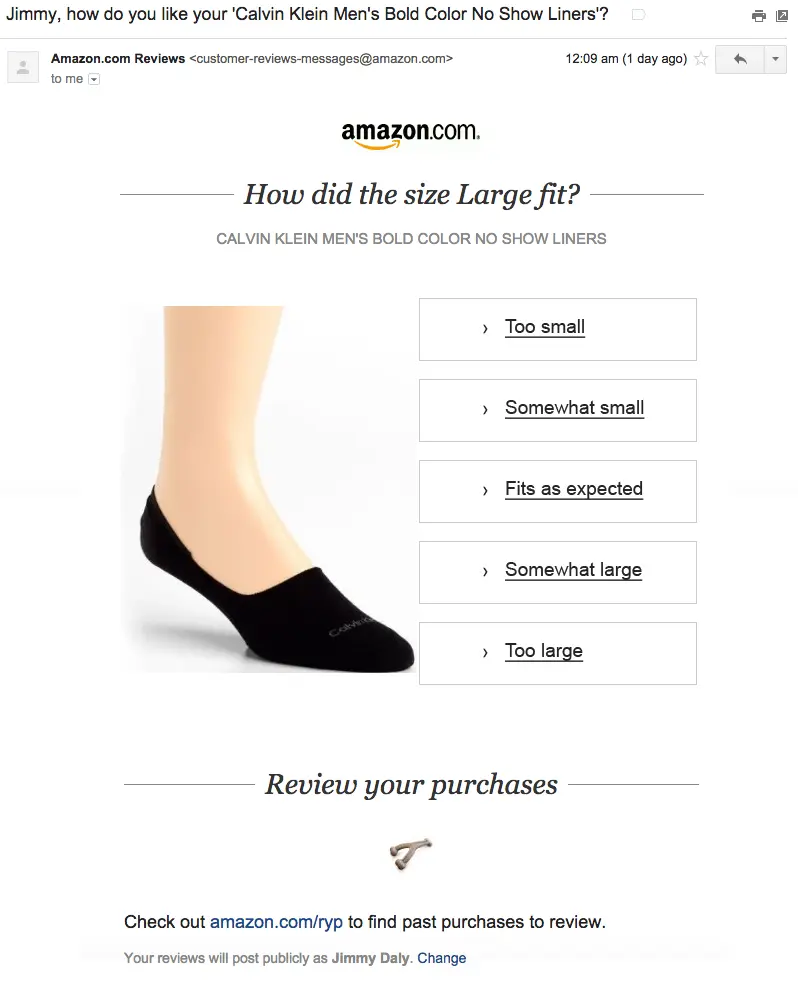
TripAdvisor
Gamification is a habit-forming marketing strategy that employs badges, awards and points to encourage engagement. Read way more on that in this SlideShare from Nir Eyal and check out the snippet from the TripAdvisor email to see it in action.
Did you know? You can collect Reviewer badges on TripAdvisor just for sharing your opinions. The more places you review, the more badges you can collect. You’re just 3 reviews away from getting your Reviewer badge. Share your latest finds.
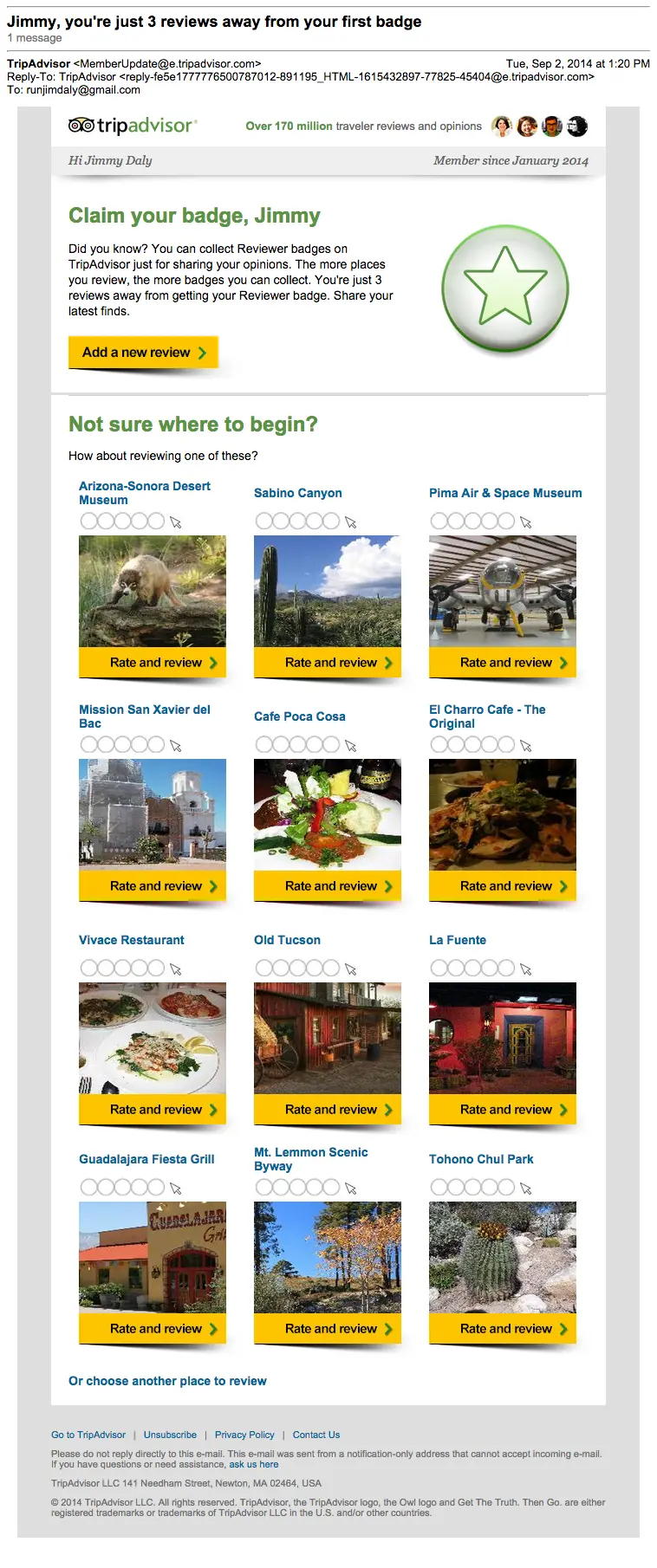
Recommendation Emails
This is low-hanging fruit for just about every business.
If you have any data on your customers, users and readers, you can recommend something to them. It could be a product, additional reading or even referrals.
This is where promotional email marketing makes the leap into data-driven, behavioral email marketing. It might seem like a small leap but there’s a big difference.
Amazon
Amazon identifies pet owners based on purchase history. Based on their data, they can expect that pet owners will be spending a lot of money on their pets (Americans spent $55 billion on pets in 2013)
This email works because it’s so direct. Essentially, it saying “You know you need stuff for your dog, you might as well save some money on it.”
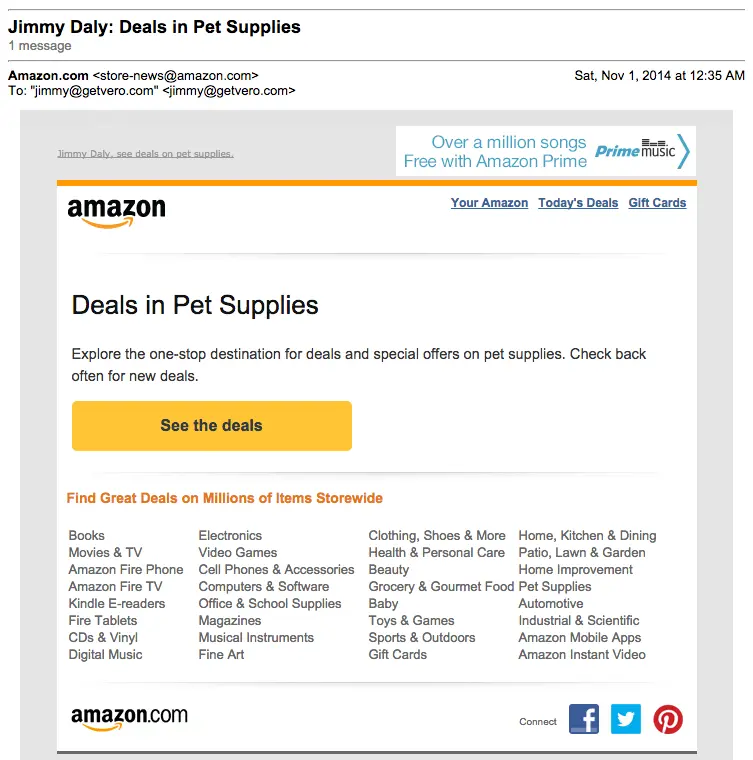
LivingSocial
LivingSocial uses location to offer suggestions. In this email, they show the customer a number of options nearby. It’s just one of many metrics you can use to determine what offers, products or services would also be relevant.
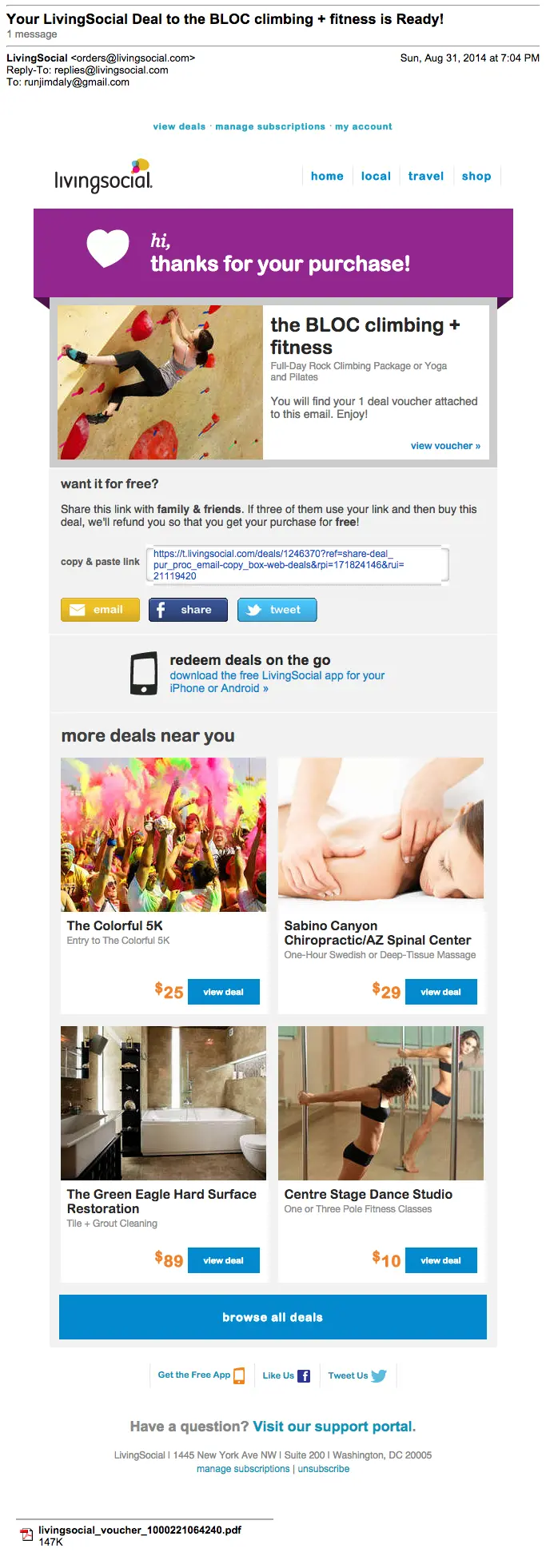
Medium
We haven’t used many examples from publishers because most publishers aren’t doing sophisticated email. Medium, however, is bucking the trend.
This email shows stories that my friends have either written or recommended. This is neat because they could send this email to every Medium user and every user would receive an entirely unique email.

TripAdvisor
Because TripAdvisor integrates with Facebook, they can give me recommendations based on what my Facebook friends have done. We’ve blurred out the names in the email but these are people we actually know who have traveled and written reviews on TripAdvisor.
Remember that “Write a review” email? This is how that data is used to market to other users.
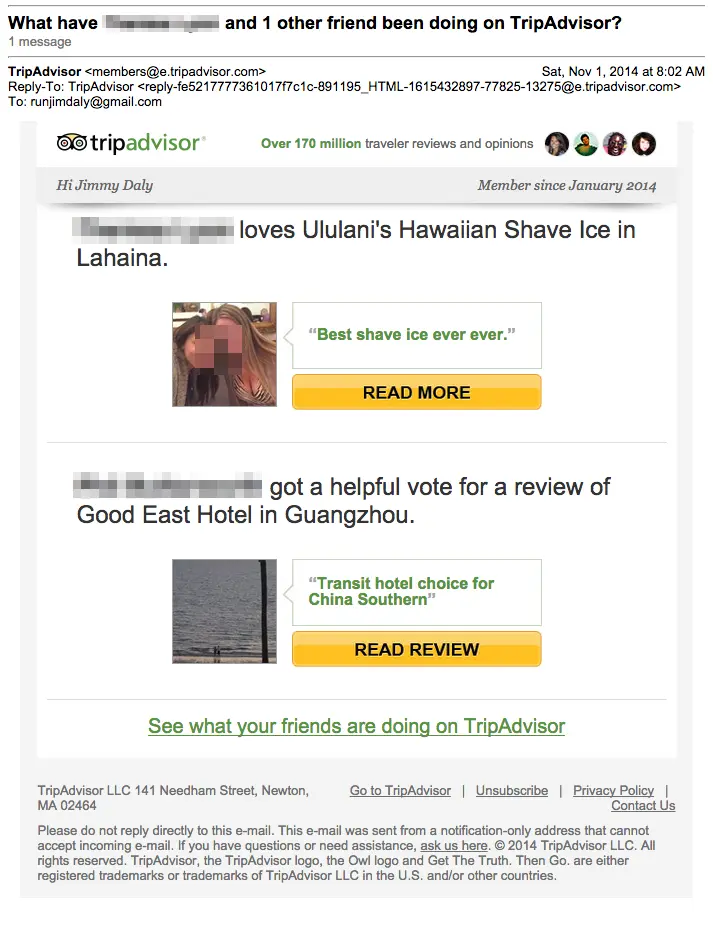
Survey Emails
Surveys provide incredibly detailed feedback for businesses. When asking people to fill out a survey, it’s wise to rely on the same conversion tactics you would use in the rest of your marketing.
Barbell Shrugged
We call this the “Call to Arms” technique. Barbell Shrugged (a strength and conditioning podcast) is asking listeners to give feedback that will shape future products.
CrashPlan
This is a nice, clean email with a strong call to action. Exactly what users need to get going.
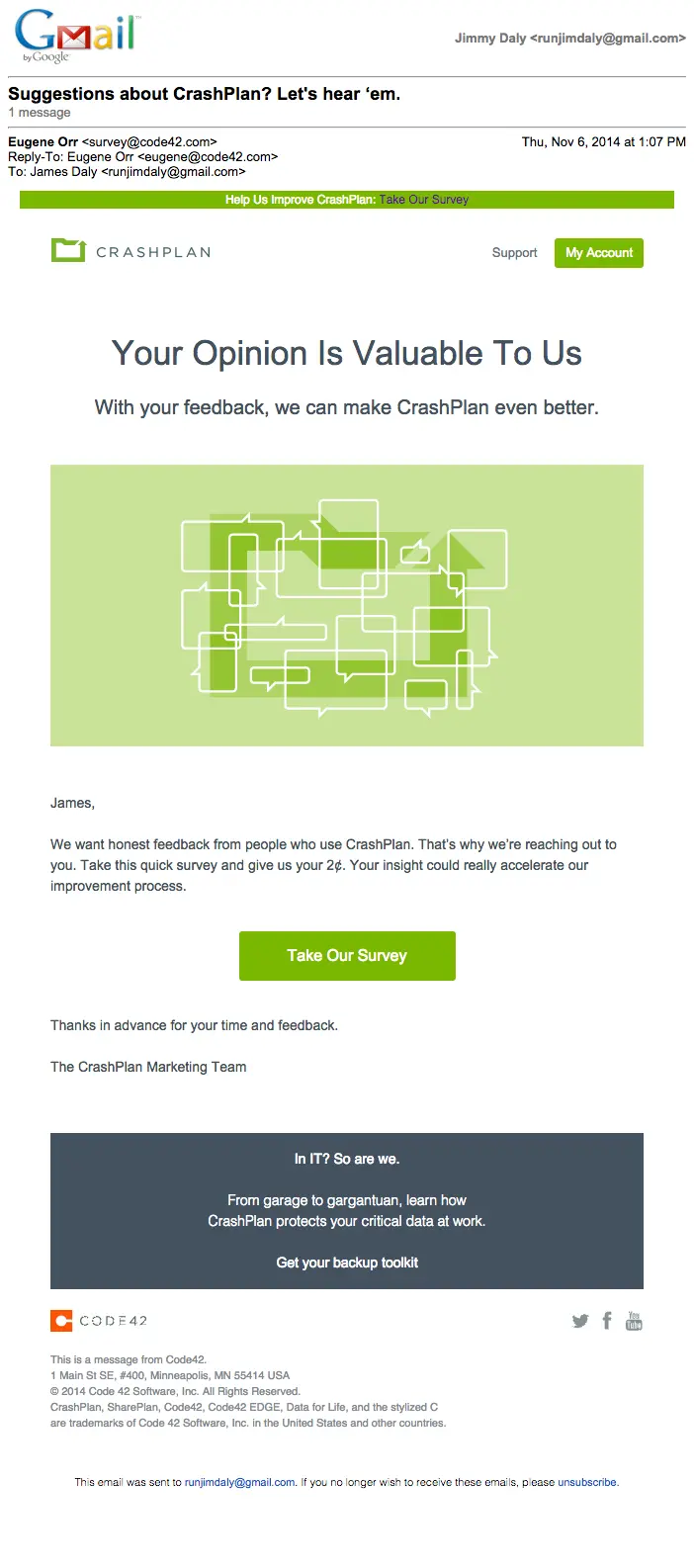
RunKeeper
Here’s a much more personal example. It works because it’s not pushy and it doesn’t feel like a marketing email … it feels more like a friend asking for a quick favor.
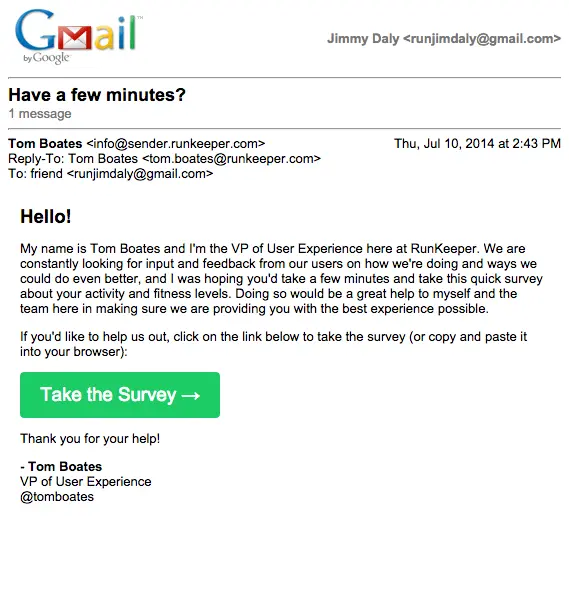
Milestone Emails
Milestone emails are designed to deepen relationships, not create them, which means they will mostly be sent to existing users and customers.
A strong milestone accomplishes three main goals:
- Rewards people for “good behavior”
- Reinforces the value your product is delivering
- Builds on the momentum by moving them to the next step
Here are a few great examples.
Canva
Here’s another example of gamification in action.
The imagery makes it clear that the user has reached level two but still has more work to do to get to level three.
Notice how Canva has also included links to their blog and social media where users can get inspiration to create designs.

Evernote
Engagement is good but deep engagement is better.
This Evernote email congratulates the user on using Evernote, then offers some tips for more advanced features.
Evernote knows this user is ready to take it to the next level based on their behavior. It works because they make the user feel really good about what they’ve done so far and tell them exactly what to do next.
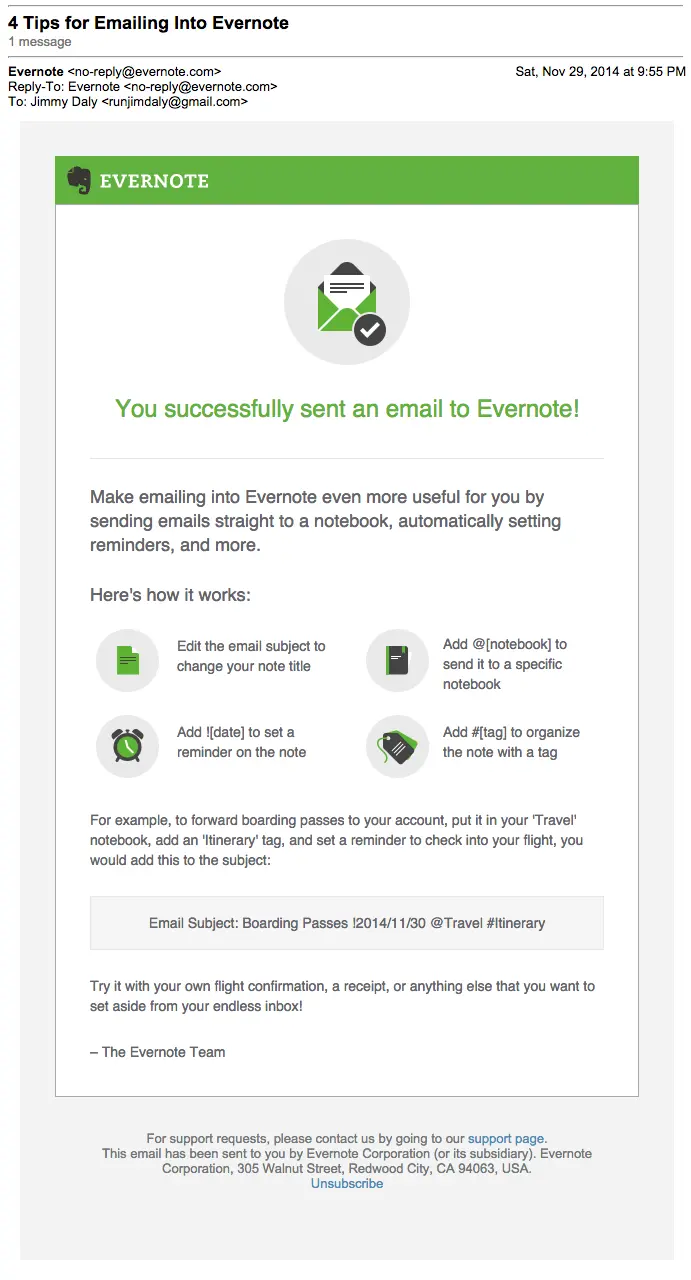
Starbucks
For every 12 drinks you buy at Starbucks, you get one free. This is the email they send. It’s transactional and behavioral email chock full of email best practices.
- Includes referral link
- Tells the customer what to do next
- Delights the recipient
- Reminds customers that they part of an exclusive club
- Includes links to follow on Twitter and Facebook

10. Social Proof Emails
From the KISSmetrics blog:
- Over 70% of Americans say they look at product reviews before making a purchase.
- Nearly 63% of consumers indicate they are more likely to purchase from a site if it has product ratings and reviews.
Social proof is the reason community-driven sites thrive. Consumers trust what other consumers think. The principle can easily be applied to email marketing.
Medium
When multiple people that I follow recommend an article, Medium triggers an email to me. But it’s really from my circle of peers, Medium is just the platform.

Nuzzel
Nuzzel’s entire app is designed around surfacing content that people within your network are sharing. They actually put a number next to articles that show you how many of your friends have shared the content. It’s an interesting way to drive clicks since the content is organized in descending order.
Other businesses can leverage the same tactic by including numbers in their emails. Comments, page views, and shares are great places to start.

Twitter emails you tweets that people you follow have interacted with.
They show you the tweet, then follow it up with context by telling you exactly who shared it. This helps users find new people and new content to follow.

Retention Emails
Retention emails are the lowest-hanging fruit of the customer lifecycle.
It’s hard to increase your lead velocity rate and optimize your conversion to bring on new customers. Inactive users have already gone through that process and you’ve already invested time and money in them. They see value in your product and were, at some point, ready to become a customer.
Turning inactive users into active users is one of the easiest ways to generate revenue.
As our CEO Chris Hexton wrote on the CrazyEgg blog, retention equals revenue and email is the best way to do it.
Even if you’re acquiring the right sort of customers and activating them rapidly it’s super important to continue to monitor customers that go inactive and to prompt them to come back and use your software or purchase again. To maximize retention, spend a lot of time ensuring your customers don’t leave.
Clicky
This email works because there is no fluff.
Cliquey explains that you are going to lose your data unless you login. And just in case you forgot your password (one of the main reason people don’t log in), they have provided a link to reset it.
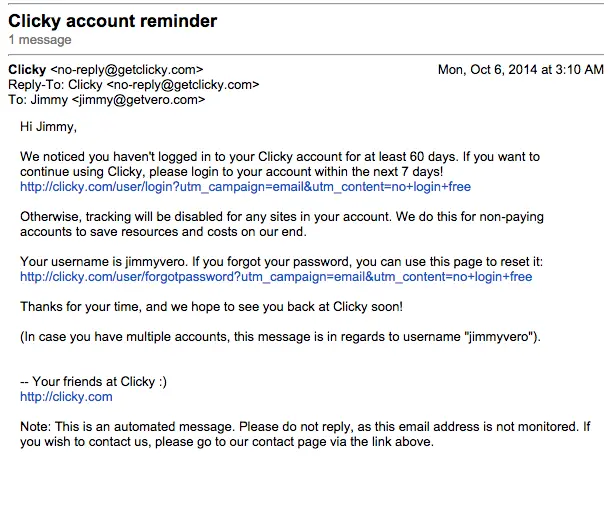
Squarespace
Squarespace takes a different approach. They do save your data and will even extend your free trial. They use the opportunity by selling the benefits of their paid product.
It looks and feels more like a marketing email, complete with a button and a call to action.
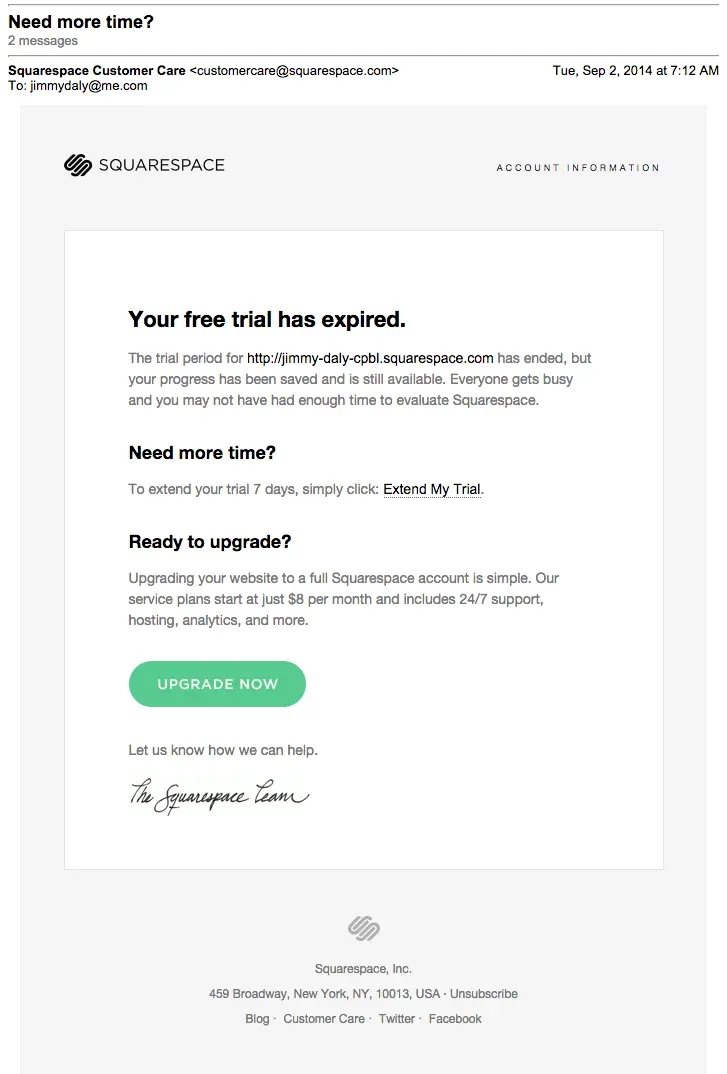
TripAdvisor
TripAdvisor’s emails are always jam-packed with context. These are hotels I actually looked at on the site along with a few others nearby.
The call to action is friction-free. By asking me to look at prices rather than “Book Now!”, they have a better chance of getting me onto the site where I can see pictures, reviews and more information.
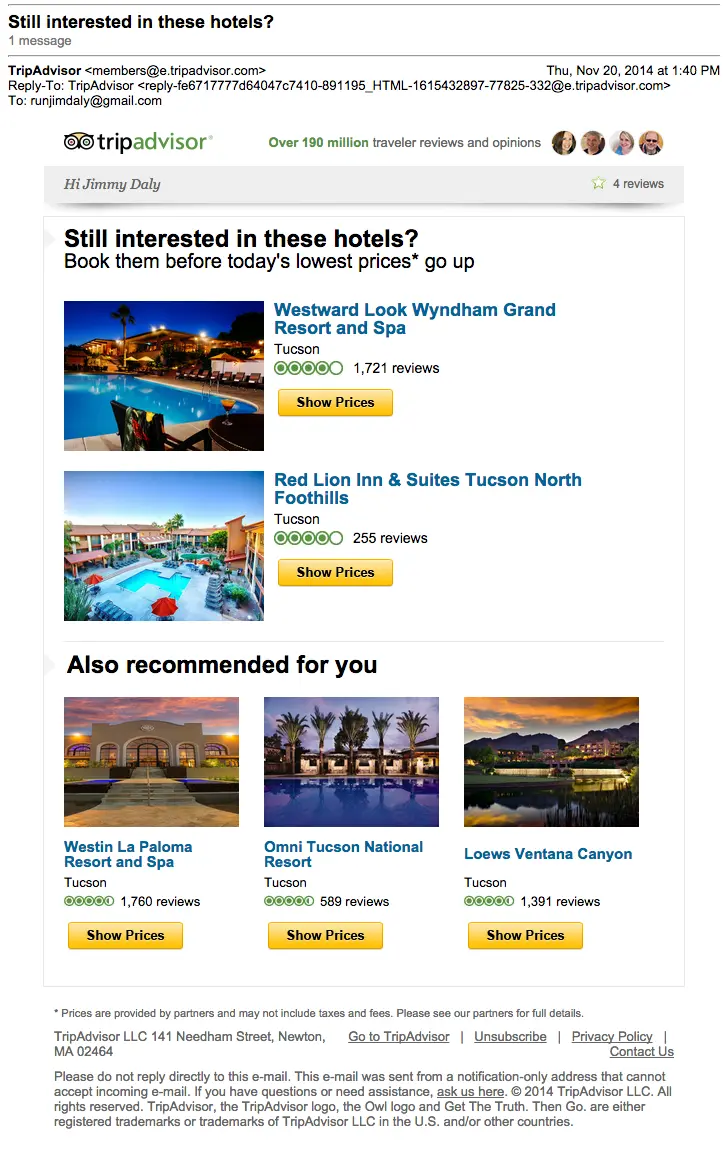
Vero
Here is an email we actually send at Vero.
It’s very personal and it’s provided us with a TON of useful feedback.
